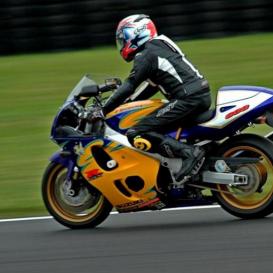Whether in a car or on a bike, track days are enormous fun – but not without their risks. Here are Kettle’s top 10 tips for anyone planning their first track day.
Leave your ego at home
It is important to remember that you are not a racer and no one is expecting you to be breaking lap records on your first time out. Even if you are a demon around you local biking roads, you must remember that you are new to this environment and it should be treated with the respect it deserves.
Take it one step at a time and gain confidence slowly. There are plenty of laps for you to get faster and faster, even if you are just there for an evening session.

Get there early
Doing a track day is hugely exciting. However, if you have never done it before, it can also be a hugely daunting prospect. This is why it is important to get there early.
There are a number of things to do before going on track, including signing on, getting your bike noise tested and attending a safety briefing.
If you are nervous, the last thing you need here is to be scrambling around at the last minute to get this done. You need chance to settle into your surroundings and calm your nerves before you go out, in order to make the most of your track time.
Make sure the bike is prepped for the day
Fold in your mirrors. The last thing you want or need is to be distracted by the riders behind you. Your focus needs to be on what is in front of you.
Make sure your bike isn’t too loud. Pretty much all UK racetracks are now suffocated by noise limits. An unfortunate fact of life, your bike needs to comply with these rules and failure to do so will result in no track time.
Ensure your bike meets regulation by using a stock exhaust, or make sure the baffle is inside your after-market can, as well as checking the noise level before you go.
Check your tyre pressures. Though these vary amongst machines, the general consensus is that you need a lower pressure on track than you will for the roads. There is no set pressure reduction and opinions vary amongst riders, so it is best to do some research on your bike before the day.
Have the correct bike gear to ride
For track days, the rule of thumb is that you need an ACU approved crash helmet (one with a gold sticker) that can be properly fastened, along with motorcycle boots and gloves and either a one or two-piece set of leathers.
If you have two-piece leathers then they must be able to be zipped together.

Drink plenty of water
Riding around a race circuit, regardless of your pace, is highly physical and requires a lot of energy. This means that in between your time on track it is important to stay hydrated. The easiest way to do this is by drinking water, so make sure you have access to plenty.
You need to be handy with tape
Along with my earlier recommendations on how to prepare your bike, it may also be a good idea to tape up parts of your machine.
For starters, your lights and indicators should be taped up. This is for the benefit of other riders, because if you crash the tape will prevent these parts smashing and shattering all over the track.

You should tape over your speedometer too. On track, you need to be focussed on the task in hand and not how fast you are going. Though it makes for ultimate bragging rights in the pub, it can be a huge distraction to you on track and should be avoided. Just simply leave the rev-counter visible for gear changes.
Don’t concern yourself with other riders
If this is your first time on track then chances are you will not be the fastest person out there – even in the novice group. It is important, therefore, to not concern yourself with other, quicker riders. This is because it will usually end in one thing, a crash.
The only time you should ever intentionally pursue a faster rider is when following an instructor. You can often ask at these events to go out with one of them in order to learn the lines of the circuit, helping you to get faster with the knowledge of a professional.
Don’t ride to the event if you can afford not to
I do not wish to tempt fate, but if you have access to some sort of van or trailer, then you should use that to transport your bike to the track. This is for two reasons.
Firstly, if you crash your motorcycle then the chances are it will be unfit for the purpose of riding home at the end of the day.
Secondly, after a day of thrashing your bike around the track, it can be hard to readjust to the world of roads and speed limits, potentially resulting in either a crash or a speeding fine and points.
Listen to the safety briefing
Before you are allowed on track, you must sit and listen to a safety briefing. This is not very long and is hardly complex, but it is important none the less. This is because failure to respond to flags and signs shown by marshals could result in injury to you or others and could get you thrown off the track.
Most importantly – have fun!
You have paid your hard-eared money to be here and so it is important that you have fun. Follow these simple steps and listen to what they tell you on the day and you should have an excellent time.









